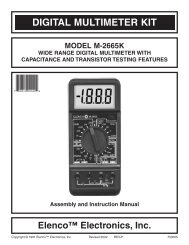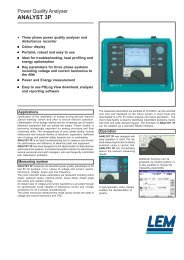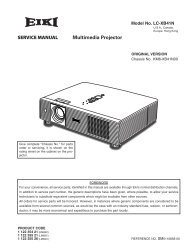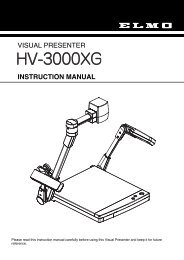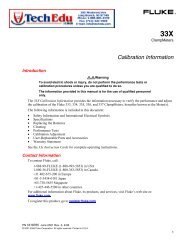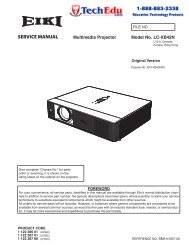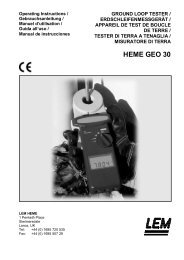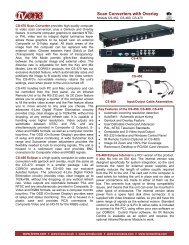transistor/diode tester model dt-100 - TechEdu.com
transistor/diode tester model dt-100 - TechEdu.com
transistor/diode tester model dt-100 - TechEdu.com
Create successful ePaper yourself
Turn your PDF publications into a flip-book with our unique Google optimized e-Paper software.
6. When the <strong>transistor</strong> is shown to be OK, the base current controlgives an indication of <strong>transistor</strong> beta. The lower the settingrelative to another <strong>transistor</strong>, the higher the beta. Lamps NPand PN measure base current. Higher base current results in abrighter LED. It also indicates if current is entering or leavingthe base, thus, NP or PN respectively will light.Transistor Testing - In CircuitThe DT-<strong>100</strong> will test <strong>transistor</strong>s in circuit, provided the base biasingresistance is greater than <strong>100</strong>W. Simply follow the previousprocedure for testing out of circuit <strong>transistor</strong>s. Do not apply powerto the circuit of the <strong>transistor</strong> or <strong>diode</strong> under test. The DT-<strong>100</strong> willsupply the necessary power.CHECKING OUT YOUR TRANSISTOR/DIODE TESTERThe following is a simple procedure for testing your DT-<strong>100</strong>.Diode Operation:1. Place the switch in the <strong>diode</strong> position. Short the black and redleads together and push in the test button. The <strong>diode</strong> test LEDsshould alternately go on at about a 1Hz rate.2. Connect the red and black leads to any good <strong>diode</strong>. Only one LEDshould flash, identifying the red lead connection (anode orcathode). Reversing the leads should cause the other LED to flash.Transistor Operation:1. Place the switch in the <strong>transistor</strong> position. Short the yellow (B)and black (E) leads together. Press the test button. Vary thebase current control. The NP lamp should light with the switchin the NPN position and the PN lamp when the switch is in thePNP position.2. Place a known good <strong>transistor</strong> in the test socket with the Emitterin E, Base in B and Collector in C pins. Be sure none of theleads are shorting. Vary the base current control. The OK LEDshould light up. Note that on the NPN <strong>transistor</strong>, the NP lampalso will glow very slightly. This indicates the base current, an<strong>dt</strong>hus lower intensity. The base current control should beadjusted for the lowest setting with the OK lamp glowing.THEORY OF OPERATIONNote the schematic diagram on page 6. The test <strong>transistor</strong> in thiscircuit is an NPN. Adjusting the variable resistor will cause theNPN LED to light up indicating that the base current is flowing. Theoutput of the test <strong>transistor</strong> is fed to amplifiers Q2 and Q3. Theoutput of Q2 is feedback in phase to the base of the test <strong>transistor</strong>causing the circuit to oscillate. Part of the oscillations are fed to apower rectifier, Q5, which switches on the OK LED indicator.The design configuration is such that in-circuit <strong>transistor</strong>s can bemeasured, provided that the base and collector resistors aregreater than <strong>100</strong>W.When measuring PNP <strong>transistor</strong>s, the power supplied to the test<strong>transistor</strong> is reversed via the NPN/PNP switch. Therefore, the PNLED will light up.Varying the base current control will reduce the base current. Thelower the base current, the higher the gain of the <strong>transistor</strong> undertest. Comparative tests of two <strong>transistor</strong>s’ gain (beta), can bemade by observing the dial setting or the intensity of the base LED<strong>diode</strong>. The lower the setting with the PN LED lit, the higher thebeta of that <strong>transistor</strong>.On <strong>diode</strong> operation, power is applied to IC1. This causes thecircuit to oscillate at about a 1Hz rate. Placing a <strong>diode</strong> in serieswith the LED indicators will cause a current to flow, depending onthe direction of the <strong>diode</strong>. Thus, the red test lead will identify thecathode or anode of the <strong>diode</strong> via the LED readout. Transistor Q4reverses the current flow in this circuit.All types of <strong>diode</strong>s may be tested: Silicon, germanium, LEDs orzeners over 6 volts. Zener <strong>diode</strong>s under 6V causes the secondLED to glow at lower intensity, indicating that zener breakdown hasoccurred.-3--4-



